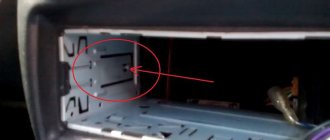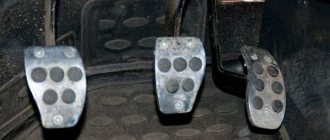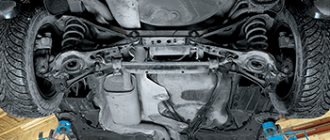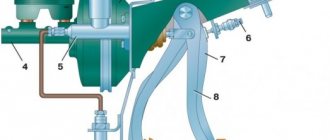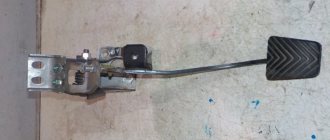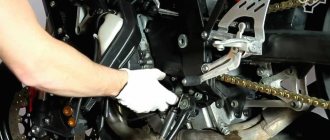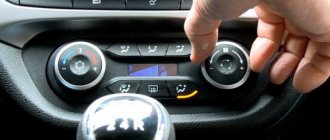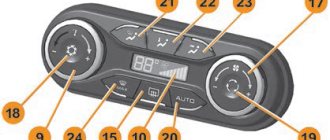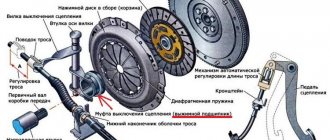On cars of the Lada Vesta and X-RAY family, a standard clutch unit with one disc is pre-installed. The contact between the clutch and the drive disk occurs under the influence of a pressure spring.
The main difference between a manual and robotic gearbox is the type of drive:
- Manual transmission: hydraulic;
- AMT: electromechanical.
Repairing a clutch is quite complicated; it is better not to try it without experience in servicing; use the services of professional workshops. It is quite possible to do the diagnosis yourself.
Why does the clutch pedal click on the Lada Grant?
Often, owners of the new Lada Grana complain about the clicking of the clutch assembly. In most cases, the reason lies in insufficient lubrication of the drive cable.
Lubricating the cable yourself is not difficult. The lubrication procedure is described above; read additionally if repairs are necessary.
Sometimes the cause of the clicking sound lies in a faulty sensor (clutch pedal switch) located on the rear side. For dismantling and subsequent replacement you must:
- Remove the block with wires coming from the dashboard.
- Unscrew the two screws securing the base of the board to the pedal and replace the part.
- Reassemble in reverse order.
Other malfunctions, such as loose pedals, stiffness, failure, are also associated with cable stretching, fiber delamination, winding damage, and worn out hinges.
The reason for the squeaking clutch pedal on the Lada Grant
The design of the clutch on the Lada Granta car is different from previous VAZ models. The shaft drive is activated by a cable with an automatic tensioner.
If the adjustment was made correctly from the factory, then the owner does not need to re-adjust the strain relief. In practice, this is far from the case; problems do happen. Especially at the stage of passing the first and second technical inspections.
Stage No. 1 Adjusting the clutch pedal of Lada Granta
The appearance of third-party noises and squeaks indicates the need for preventive maintenance and troubleshooting of clutch elements. First of all, we check the clearance on the drive fork.
In the engine compartment, dismantle the plastic casing of the air element and remove the pipes. Using a caliper, measure the size of the gap between the plastic wing and the fork. The factory standard is 27 mm, exceeding or reducing the length is unacceptable. We correct the gap by unscrewing the nut (key set to “10”).
Stage No. 2 Lubrication of elements
Lubricating the moving elements of the pedal assembly, including the compensator ratchet, clutch pedal bushing, and cable sheath.
To simplify the lubrication process, we use a grease gun, fill a medical syringe with transmission oil, and apply it to the surface.
Sometimes the creaking comes from the engine compartment. The reason is the leash of the tip. To eliminate squeaking, apply oil to the contact area between the nut and the drive fork.
Stage No. 3 Insufficient amount of lubricant
In rare cases, the cause of the squeak is the lack of lubrication on the input shaft of the gearbox. The defect is eliminated by applying graphite lubricant to the surface of the shaft. First remove the rubber bushing and spray lubricant using an aerosol can.
Step-by-step instruction
Replacing the clutch on a Lada car will require a lot of time, effort, money and experience. Many car enthusiasts practice DIY repairs due to the high cost of professional services.
Prevention is complicated by the fact that the VAZ design has a pre-installed subframe that limits access to the units. In order to provide methodological assistance to owners of technical equipment, using the Lada Vesta car as an example, we will consider the process of independently replacing the clutch.
FakeHeader
Comments 14
I also wanted to get confused, bought the 10th cable, went to the service center, removed the old one and then surprise, the factory cable was 10 cm longer than the 10th (Kalina 1 ’13) and the bummer had to be replaced with a Kalinovsky one.
Like for your efforts. But. For example, I have a stock cable and am quite happy with it, sometimes it clicks once every now and then, but it doesn’t bother me because it happens very rarely. True, I myself re-adjusted it according to the manual and lubricated it, after the adjustment I pressed the pedal several times, the device tightened it and that’s it, I drive, nothing bothers me.
When I was working on getting rid of the squeak, I also wanted to do the same thing (although it can be cheaper to buy both the cable and the fastener at a disassembly) until half a year later nothing creaks. I installed it while there is a spring in the BZ. So far I’m happy with it and another option is to press in another loop and not change the entire cable.
and someone else had another option - remove the machine gun and weld a metal ring to the end of the cable.
you can't weld it to the cable. only if you fill it with tin. Separately solder the cable with acid and then pour it into the tube.
On the pedal side, the cable already has a metal tip with teeth. I saw someone had it welded to it.
I thoroughly lubricated the auto-tensioning mechanism and there was no squeaking or squeaking.
The only inconvenience of the standard clutch for you is clicking, and this is completely normal, does not affect the ride in any way, does not irritate me, an absolutely pointless idea, you will still change to the classic! There's also a gap you can adjust at the bottom, which is cool. Looks like the world has gone crazy! Sorry, I just can’t get my head around this alteration, you’re looking for problems for yourself! On the contrary, they did it well; there is no need to adjust anything during operation. For example, a friend of mine drove a two-wheeler with his leg stuck in the knee due to manual adjustment, until I adjusted everything properly for him, and one wonders why go against real improvement.
So everything started well and ruined everything with the last phrase. It's a pity, it's a pity.
The technique is not suitable for everyone. It won't work like that on a cable car.
The right thing to do! Good job!
Add to favorites, I've been wanting to do the same thing for a long time!
You have an old box with a short cable, on a new (cable) box 2181, there is a longer clutch cable, your method is only suitable for grants with black bumpers where the old box has a rocker.
Clutch malfunctions on AMT. Ways to eliminate them
The robotic version of the Lada Vesta box is not ideal. The most common breakdowns are associated with knocking, howling, roaring when shifting to higher gears.
A faulty release bearing is a source of extraneous sound. When replacing discs, the bearing must be replaced, regardless of the actual condition.
The AMT needs to be repaired (adapted) at a service station, but you can carry out preventive maintenance yourself.
Algorithm of actions:
- Turn the ignition key to position “2”, depress the brake, and alternately move the gear lever. Check that the numbering on the dashboard matches the transmission.
- Turn on the engine, listen to possible sounds coming from the transmission. Most likely, the release bearing, the pressure spring are faulty, or the clutch on the robot is overheating.
- With the engine active, switch the selector to different positions. The transition should be easy, without crunching or knocking. Otherwise, the release bearing must be replaced. Less common are breakdowns of the electromechanical drive and burning of the clutch on Lada Vesta. The transmission control unit is subject to prevention.
- Engage neutral gear, squeeze and release the brake. The car should not move.
- Engage first gear and gently press the accelerator. The ride is quiet, without jerking.
- We switch the AMT to manual control mode and change gears step by step. The transmission operates normally.
To carry out comprehensive diagnostics, contact certified service stations.
Conclusion
It is not difficult to independently diagnose an automatic or manual transmission. Another thing is repair, or as it is called for a “machine” - adaptation. It is impossible to do without the skills of specialists and specialized equipment. When purchasing components, carefully check the catalog numbers with the data specified in the instruction manual.
Reviews
| № | Positive |
| 1. | Semyon (www.zr.ru): mileage 50,000 km, clutch works in normal mode. |
| 2. | Andrey (autobann.su): I drove Vesta for two seasons without any comments, the build quality is acceptable. |
| 3. | Georgy (lada-vesta.net): there are no comments on the flywheel or transmission, they work stably. |
| 4. | Stepan (otzovik.com): the pedal catches me under the top, it’s uncomfortable at first, but I’ve already gotten used to it. |
| 5. | Vladimir (www.zr.ru): positive review, no comments. |
| 6. | Alexander (autobann.su): I’m happy with the Lada, I bought it from scratch. The only drawback is the occasional knocking sound in the box when shifting to lower gears. |
| 7. | Mikhalych (forumvesta.ru): drove 70,000 km, there were no critical breakdowns, he fixed “small things” on his own. |
| 8. | Vitaly (lada-vesta.net): I recently underwent scheduled maintenance, the master said that there were no comments on the condition of the car. |
| 9. | Timofey (otzovik.com): three years of successful operation of the car. |
| 10. | Stanislav (www.zr.ru): Before Vesta there was Priora, the quality is incomparable. Finally, a domestic manufacturer has learned to assemble cars. |
| 11. | Gennady (autobann.su): in two years I replaced the brake fluid once, the clutch was normal, there were no comments from the master. |
| 12. | Alexey (https://forumvesta.ru): I treat the car with care, I regularly carry out maintenance, it is in good condition, all components are in good working order. |
| Negative | |
| 13. | Konstantin (www.zr.ru): problems with the clutch and gearbox began after 15,000 km, since then I have been a frequent visitor to the workshop. |
| 14. | Vitaly (otzovik.com): dissatisfied with the assembly of the Lada Vesta, there are many defects. Recently the transmission failed, there was a squeaking noise and a clutch smell in the cabin. |
| 15. | Grigory (autobann.su): why make a model if defects are inherited. In particular: transmission, chassis. |
| 16. | Kirill (lada-vesta.net): periodically I do something near the car, sometimes I ask the mechanics to help. Lately the clutch on the Lada Vesta has been slipping. |
Related link:
Adsorber Lada Granta: signs of malfunction, solutions, replacement
The clutch does not disengage (drives)
Often, the Lada mechanism does not fully release due to the hydraulic clutch release. This could be due to poor drive adjustment, leaking fluid system, or cable wedge. Such breakdowns are easily eliminated. It is much more difficult when one of the elements of the main device breaks down.
If the mechanism does not completely disengage, it means that something is holding it: a deformed driven circle, the formation of dirt, rust in the spline joint, flywheel wear, as well as a change in the shape of the release fork, weakening of the pressure plate. In all cases, the disk will need to be replaced.
Clutch malfunctions on manual transmission. Ways to eliminate them
The hydraulic drive consists of a pipeline, main and working cylinders. The main part of the structure is located in the crankcase. Brake fluid simultaneously performs the functions of “hydraulics”
That is why it is so important to change DOT-4 in a timely manner and carry out unit prevention
The most common mechanical failures:
- airiness of the circuit, as a result of which the speeds are switched tightly, unclearly, with obvious effort;
- wear of the cuffs in the cylinders, resulting in audible clutch knocking;
- brake fluid leak, system depressurization;
- clutch pedal squeaking;
- third-party mechanical damage to cylinders and pipelines.
The design of the hydraulic drive is quite reliable, unlike the electromechanical one, and has a long service life. A breakdown can occur at the most inopportune moment due to air getting inside the circuit.
To independently diagnose the manual transmission hydraulic drive, follow the instructions:
| What to do | What will happen |
| Turn off the engine, hold down the clutch pedal (hereinafter referred to as “SC”). | No outside sounds should be heard. The stroke of the PS is smooth, without jamming, with pick-up 2/3 of the way. |
| Start the car. | Clutch noise is heard - depress the clutch. If the sound disappears, then there is a problem with the release bearing and it must be replaced with a new one. |
| Start the engine, depress the gearbox, and engage first gear. | There should be no knocking of the clutch pedal in Vesta and other third-party sounds. Otherwise, these are the first signs of incomplete disengagement of the clutch, malfunction of the master and slave cylinders, and the diaphragm spring. |
| With the engine running, shift to second gear and smoothly release the clutch. | A knocking sound is heard when the clutch is released - a sign of damage to the disc, damper, or transmission oil getting on the working surface. |
| While driving, press the accelerator sharply. | The revolutions have increased, but the speed has not increased - the damper is slipping. The interior of the Lada Vesta smells like clutch. |
If none of the above methods help, then contact a workshop for comprehensive diagnostics by specialists using digital equipment.
Messages 21
1 Topic from Serenty 2017-09-12 21:38:15
- Serenty
- Participant
- Inactive
- Messages: 10
- Thank you: 0
Topic: Knocking noise when pressing clutch pedal!
Hello! I drove the West for 500 km and a problem appeared! When you press the clutch pedal or at the moment of return, a knock is heard in the engine compartment! The frequency is different, it clicks constantly, sometimes not, sometimes every other time! what is on the establishment and what is not! as if something is catching somewhere. Can you tell me who has encountered a similar miracle?
2 Reply from Patriot 2017-09-13 03:18:46
- Patriot
- Participant
- Inactive
- From: Irkutsk region.
- Messages: 3,156
- Thank you: 443
Re: knocking sound when pressing the clutch pedal!
Serenty , it’s better for you to contact the service
3 Reply from antifashist 2017-09-13 10:09:12
- anti-fascist
- Moderator
- Inactive
- From: Salavat, Bashkortostan
- Messages: 708
- Thank you: 73
Re: knocking sound when pressing the clutch pedal!
There is no such thing.
If the OD is far away, then you need to look together. One presses (causing a knock), the other probes. You need to check the pedal itself, its bracket, the linkage to the hydraulic cylinder and its fastening. The drive is then transmitted through liquid. She can't knock. Therefore, we immediately check the clutch slave cylinder (mount) and rod. You won’t be able to get close to the basket unless the OD is super far away. At the first stage, you need to localize the source of the knock, and then you will see. Write if you need anything.
4 Reply from Serentiy 2017-09-14 20:44:38
- Serenty
- Participant
- Inactive
- Messages: 10
- Thank you: 0
Re: knocking sound when pressing the clutch pedal!
There is a knocking noise coming from the checkpoint, as if something is being bitten! I'm planning to visit the dealer on Saturday!
5 Reply from Patriot 2017-09-15 03:10:52
- Patriot
- Participant
- Inactive
- From: Irkutsk region.
- Messages: 3,156
- Thank you: 443
Re: knocking sound when pressing the clutch pedal!
Serenty , Keep us posted.
6 Reply from Serentiy 2017-09-15 10:12:22
- Serenty
- Participant
- Inactive
- Messages: 10
- Thank you: 0
Re: knocking sound when pressing the clutch pedal!
Certainly! I think the problem here is in the release fork area.
7 Reply from antifashist 2017-09-15 11:24:21
- anti-fascist
- Moderator
- Inactive
- From: Salavat, Bashkortostan
- Messages: 708
- Thank you: 73
Re: knocking sound when pressing the clutch pedal!
Perhaps the release bearing is wedged along the guide. Now the main thing is that the OD has a normal mechanic and a “guarantor”.
8 Reply from Serentiy 2017-09-15 13:55:10
- Serenty
- Participant
- Inactive
- Messages: 10
- Thank you: 0
Re: knocking sound when pressing the clutch pedal!
Quite possible. I'll see what the dealer says tomorrow! just kick me off
9 Reply from Serenty 2017-09-16 12:47:20
- Serenty
- Participant
- Inactive
- Messages: 10
- Thank you: 0
Re: knocking sound when pressing the clutch pedal!
I visited the dealer. We made an appointment for 27.09 to remove the box and see what clicks there
10 Reply from rvs 2017-09-17 20:10:23
- rvs
- Participant
- Inactive
- Messages: 97
- Thank you: 31
Re: knocking sound when pressing the clutch pedal!
I visited the dealer. We made an appointment for 27.09 to remove the box and see what clicks there
Just keep in mind one nuance: if they remove the gearbox and don’t find anything seditious, and this is almost 100%, then you will pay for removing the box and installing it back out of your own pocket.
11 Reply from antifashist 2017-09-18 07:28:02
- anti-fascist
- Moderator
- Inactive
- From: Salavat, Bashkortostan
- Messages: 708
- Thank you: 73
Re: knocking sound when pressing the clutch pedal!
Here a lot depends on the ML policy. Since they signed up for further diagnostics, it means they detected extraneous noise that did not meet the standards. Was there a warning that “we will look, but if no warranty issues are found or the master is blind, you will pay for the work performed yourself . In this case, ML is a concern. Only Serenty knows about this so far. But it could have been different. OD, not seeing the reason for the knocking, wants to go deeper himself, look, feel. The client doesn’t ask him for this, then all the work is covered by the guarantee, but how they arrange it is their problem. I repeat here:
Why does the clutch pedal click on a Lada Vesta - the degree of danger and the design of the assembly module
Design
The situation in which the box clicks when you release the clutch on the Lada Vesta or squeeze it in is typical for products from both companies. Experts assure that extraneous clicks are regarded as a defect. But apart from acoustic discomfort, they will not bring serious problems such as, say, bent valves due to untimely replacement of the timing belt on the Lada Vesta engine.
Clutch
The design diagram of the unit links the work of several structural units:
- Basket.
- Driven disk with friction linings.
- Hydraulic drive.
The basket part consists of a pressure plate with a friction insert and a diaphragm spring mounted on its body. The latter is bolted in the amount of six pieces to the engine flywheel. The driven part is located between the pressure plate and the flywheel. When the pedal is released, the discs are engaged and transmit torque from the engine to the gearbox.
Drive part
The structure of the hydraulic drive includes the following elements:
- Main cylinder.
- Pipelines.
- Working cylinder.
- Expansion tank.
It is noteworthy that the design does not provide forks. The working cylinder and the release bearing are connected in one housing and represent a single part with its own article number:
- 21810160118001 – manual transmission VAZ.
- 306201586R – Renault gearbox.
Total
If it clicks when you release or squeeze the clutch of a Lada Vesta in the cabin, the reason may be in the limit switch, pedal support or hydraulic cylinder design. Knocks in the engine compartment are more serious - the dealer is less likely to refuse to find out their cause, since this may indicate a malfunction of important parts - springs, release bearings, working cylinder.
As a temporary solution to a serious knock, drivers use the accelerator. You need to get used to this: when the clutch is released, the driver applies more gas and the knocking disappears. Typically, such actions indicate defects in the release support guide.
Car owners who have experience owning AvtoVAZ models - Priora, Granta and Kalina - know that one of the problems of these cars is the background noise that comes from the clutch pedal. However, as it turned out, this trouble did not bypass the Lada Vesta.
According to owner reviews, this problem can manifest itself in different ways. The following sounds are usually heard:
It is worth noting that the causes of these noises are different, and therefore it is necessary to analyze each situation separately.
Clicks
If the Lada Vesta clutch pedal clicks when it is released, as a rule, the reason is in the fixation axis of the clutch master cylinder rod. In this case, the axis moves along the thread, which provokes clicks.
To eliminate the problem, you need to arm yourself with a flat-head screwdriver and insert its end into the gap between the clutch pedal and the head of the master cylinder rod. In this case, you need to push the clamps and disconnect the rod from the pedal. To prevent shifts, it is necessary to place a metal washer under the tip.
In the case when the Lada Vesta clutch pedal knocks precisely at the end of its pressing, and the knock itself is heard from the engine compartment, it is necessary to dismantle the resonator using a TorX T27 wrench and bit, and then remove the boot from the transmission. When this is done, Bechem High-lub L2 MO grease should be applied to the gearbox hole on the release lever stop.
What should be the clutch pedal travel of the Lada Granta?
The free play of the clutch pedal on the Lada Grant is 146 mm - this is the distance from the base of the body to the back of the pedal (frog). The manufacturer allows a stroke play of 2.0 mm.
If the above distance does not meet the standard, we carry out the following adjustment steps:
- In the engine compartment, pull the end of the cable forward as far as it will go. Using a caliper, measure the actual distance from the plastic nut to the drive fork. Factory standard 27 mm.
- We carry out adjustments and adjustments as necessary (key to “10”).
- We pump the pedal 2-3 times and take repeated measurements.
- Inside the car we measure the pedal stroke, it should be equal to 146 mm.
If the pedal travel increases/decreases, the clutch cable must be replaced with a new one. To eliminate free play, use the Lada Granta clutch pedal repair kit.
Includes:
- pressure bushings;
- plastic compensator;
- spring.
Clutch adjustment on Lada Vesta cars
Since the knot is constantly engaged/disengaged, it needs fine adjustment. Adjustments are made on site during installation. The driven disk is centered, the basket, and the release bearing are also centered - they must fit exactly into the splines of the flywheel and the input shaft of the gearbox.
In the future, you can adjust the position of the clutch cable so that the pedal is softer/harder, so that it responds better to the command (during operation, the cable may stretch).
On a Lada with a robotic gearbox, the clutch is regulated by special programs. Adaptation can only be completed at an official dealer. However, the service life of the AMT clutch is significantly longer than that of a manual transmission.
Clutch device
On the Lada Vesta, as well as on all its modifications, including the X-RAY crossover and Cross versions, a standard unit with one disk is installed. The contact of the friction and drive disk occurs under the action of a spring. The main difference between the Vesta clutch and other AvtoVAZ models is the drive.
Structurally, the Vesta clutch is designed according to the standard type and consists of a pressure and driven disc that interact with each other. A pressure disk is installed in the basket; the basket itself is a steel body. The pressure plate in the basket is pressed using a special device in the form of a spring. The clutch basket is installed directly on the flywheel of the power unit and is firmly attached to bolted connections.
A disc with friction linings is placed between the flywheel and the drive disc. The driven clutch disc is also called a friction disc due to special linings attached to both sides. A damper with springs is installed in the center of the hole, designed to eliminate vibrations when the clutch is engaged. The friction disc is mounted through the hub onto the engine input shaft.
Features of the Vesta clutch hydraulic drive
The hydraulic drive consists of pipelines and two cylinders (worker and main). From the master cylinder, the pressure from the rod is transferred to the working one. This, in turn, exerts an influence on the clamping device through pipelines. The working cylinder is a module where the release bearing is also located. All this is mounted in the clutch housing.
Brake fluid performs the functions of working fluid. To ensure the reliability and performance of the hydraulic drive, it is necessary to promptly change the working fluid in accordance with the regulations. Problems with the hydraulic drive most often result from air in the system. In advanced cases, it will simply be impossible to change gears on the car.
Features of the electric clutch drive on Vesta
The electric drive, unlike the hydraulic one, is designed slightly differently; it acts directly on the clutch fork. When the fork is turned, the force puts pressure on the release bearing, which, in turn, presses on the petals of the pressure plate spring. The release bearing is reinforced and is constantly in operation, and the spring is always pressed against the coupling due to the absence of any gaps.
The release bearing does not require periodic maintenance, i.e. no lubrication is needed, the manufacturer took care of this too. The bearing lasts a long time and is simply replaced if it fails. You can recognize this by the characteristic noise. The release plate must also be replaced when replacing the driven or pressure disks, regardless of whether the bearing is in good condition or not.
Malfunctions in the operation of the hydraulic drive can be easily eliminated with your own hands; often it is enough to bleed the system and get rid of the air. But with an electromechanical drive, troubleshooting is much more complicated. A similar procedure on automatic and robotic gearboxes is called adaptation, and it is impossible to perform it without knowledge, skills and equipment. In such cases, the only correct decision is to contact an official dealer.
Today, the AvtoVAZ plant is actively introducing modern technologies into its cars, this also applies to clutches. Nowadays, structural elements that meet international quality standards are used for this. Friction linings and springs are much more reliable and durable.
Noise when disengaging or engaging the clutch
A noise similar to rustling, grinding, a slight hum, or howling appears when the unit is turned off. When turned on, it disappears. With almost one hundred percent probability we can say that the release bearing has worn out. Replacing it does not require removing the entire component. However, its untimely replacement leads to failure of the entire mechanism. A squelching, whistling sound when you press the pedal is associated with wear on the master or slave cylinders. There is pressure, the broken part does not hold it - the liquid breaks through further, making noise. The noise in the box disappears only when the clutch is disengaged.
The second type of sound is constant, disappears only when the gear is disengaged, and is located in the area of the gearbox. The nature of the “tinkling” of Lada Vesta is a weakened connection between the three main nodes.
The worn driven circle loses its volume and begins to dangle inside the housing. Worn dampers are not able to press the circle tightly. The box is not tightly connected to the engine. Replacing the clutch on a manual gearbox
The procedure is very complicated. The main difficulty is not even that the gearbox needs to be completely removed, but that during assembly it needs to be centered in weight with the flywheel. Repairs can be done with your own hands. But if you do not have the proper experience, saving is not worth it, because we are talking about direct contact with the most important “organs” of the Lada. In general, the process looks like this:
- We de-energize Vesta, remove all attachments that block access to the gearbox mounting bolts (air filter, pipes);
- To prevent the loose internal combustion engine of the Lada from falling, we will hold it with a small diamond-shaped, barrel jack;
- We unscrew the power fasteners so as not to drain the oil, dismantle the box assembly with drives;
- We loosen one by one, then unscrew the fastening elements of the engaging mechanism housing (the bolts here are strong, but small in diameter, you need a good 8mm wrench). We remove the part and find the defect;
- We install the new product, adjust the position of the driven circle inside with a special tool;
- We change the release bearing in the box housing;
- Smoothly, without tilting, the input shaft of the gearbox hits the flywheel splines;
- We check the operation of the drive.
Not all operations are described here. For example, in order to remove the gearbox with drives, it is necessary to dismantle the suspension arms and so on.
The connection mechanism between the box and the engine is a “vitally” important element. Like any detail, it loves careful handling and timely service. The mechanism is directly connected to the internal combustion engine and gearbox; prolonged use of a faulty part can damage these two components. Do not neglect any suspicions that a unit is malfunctioning. May the car serve you for a long time.
The proper functioning of the Lada Vesta manual transmission is characterized by a monotonous, quiet sound. Violations of the factory condition occur: owners often complain of a clicking sound when operating the clutch. The official response on this matter has been disappointing. In 90% of cases, no action is even taken to eliminate the malfunction; arguments are only given in favor of supposedly additional features of the normal functioning of the mechanism.
Removing gearbox 21807
1. Place the car on a two-post lift, apply the parking brake, turn off the ignition, open the hood and disconnect the earth wire terminal from the battery.
2. Remove the front wheels from the car.
3. Unscrew thirteen bolts 1 of the fastening and remove the mudguard 2 of the engine (replaceable head 10, knob and extension).
Engine splash guard:
- fastening bolt;
- engine splash guard
4. Disconnect the pipes of the intake resonator 1 from the air intake and the air filter housing, unscrew the two fastening bolts and remove the resonator (replaceable head 10, knob).
Intake resonator:
- intake resonator;
- air filter pipe;
- air intake pipe
5. Unscrew the fastening clamp 1 and disconnect the upper hose 3 of the crankcase ventilation from the pipe of the cylinder head cover 7 (pliers).
Air filter with intake pipe hose assembly:
- clamp for securing the upper crankcase ventilation hose;
- intake pipe hose clamp;
- upper crankcase ventilation hose;
- intake pipe hose;
- air filter mounting bolt;
- air filter;
- cylinder head cover
6. Loosen the fastening clamp 2 and disconnect the intake pipe hose 4 from the throttle pipe (a Phillips screwdriver).
7. Unscrew bolt 5 securing the air filter and remove air filter 6 assembled with hose 4 of the intake pipe (replaceable head 10, knob).
8. Press down the buttons 2 of the cable end clamps and disconnect the ends of the shift cable 4 and gear selection cable 5 from the gear shift mechanism 6 levers.
Disconnecting the transmission control drive cables:
- cable sheath fastening clamp;
- button for securing the cable end;
- bracket for fastening gearbox control drive cables;
- gear shift cable;
- gear selection cable;
- gear shift mechanism
9. Move the clamps 1 fastening the cable sheaths in the direction indicated by the arrow, remove the cable sheaths from the fastening bracket 3 and remove the gear selection and shift cables from the work area.
10. Disconnect harness 4 of the ignition system wires from the block of harness 1 of the oxygen sensor wires.
Disconnecting the diagnostic oxygen sensor wiring harness:
- oxygen sensor wiring harness;
- oxygen sensor wiring harness mounting bracket;
- oxygen sensor wiring harness block mounting bracket;
- ignition system wiring harness
11. Disconnect the harness block 1 of the oxygen sensor wires from the mounting bracket 3, remove the oxygen sensor wiring harness from the mounting bracket 2 and remove the harness from the work area.
12. Disconnect the ignition system wiring harness connector from reverse light switch 4.
Disconnecting the bracket for securing the outlet hose from the gearbox:
- mounting bracket bolt;
- outlet hose mounting bracket;
- radiator outlet hose;
- reverse light switch
13. Unscrew bolt 1 of bracket 2 securing the outlet hose (replaceable head 13, knob).
14. Unscrew the two fastening bolts 1, remove the clutch hydraulic drive cylinder 2 without disconnecting the hydraulic drive tube 3, and hang the cylinder on the service hook (replaceable head 13, ratchet wrench, service hook).
Removing the clutch hydraulic cylinder:
- bolt;
- clutch hydraulic drive cylinder;
- clutch hydraulic tube;
- bracket for fastening the hydraulic clutch cylinder;
- Transmission;
- clutch release fork
15. Unscrew three bolts 1, remove bracket 2 for fastening the hydraulic clutch cylinder, remove starter 3 and hang it on a service hook (replaceable Torx E10 head, extension, ratchet wrench, service hook).
Removing the starter:
- bolt;
- bracket for fastening the hydraulic clutch cylinder;
- starter
16. Unscrew the fastening nut 1, remove the ground terminal 2 from the stud and remove the wire from the work area (replaceable head 17, knob).
Disconnecting the ground wire from the gearbox:
17. Unscrew plug 1 and drain the oil from gearbox 3 (ring key 17, installation type 24164 “ALFA” (Italy) for collecting used oil).
Hole plugs for changing the oil in the gearbox:
- oil drain plug;
- oil filler plug;
- Transmission
Sachs clutch
The production of clutches for various car brands also has its own innovations. The clutch, like all other mechanisms, wears out quickly, and every driver wonders how to choose the right mechanism. Driving style and operating conditions are directly proportional to service life. Therefore, Sachs specialists, taking into account all the wishes of drivers, have released completely new, environmentally tested flywheels, release bearings, clutch discs and slave cylinders, compact clutch units and other equally interesting design solutions. These new products include:
- MZ type clutch basket with pull-out action.
- XTend with automatic wear compensation.
- Dual-mass flywheel ZMS.
- Release bearing type CSC.
- Ultra-compact clutch unit (for sports cars).
Which clutch to install is up to you, but if the driver takes good care of his car, replacement can be done after 100,000 km. The clutch pedal is a kind of indicator of the technical condition of the engine and transmission.
Hi all. I recently talked about the reasons for clutch pedal failure, as well as ways to solve this phenomenon. Today I decided to supplement the series of articles about the clutch with another, no less relevant topic - the creaking of the clutch pedal.
You will learn about the reasons why the clutch pedal squeaks and how to get rid of it.
I’ll say right away that the creaking of a pedal, whether it’s a clutch or a brake, in most cases does not affect its functionality and, by and large, is a common irritant that infuriates many motorists. Creaking or grinding of pedals rarely indicates serious damage, but before you give up on it with the words “I still have nerves of iron,” I recommend making sure that the problem is really not worth attention.
What is the moral of this fable?
One gets the feeling that among all the shortcomings of Vesta, the main one is the low level of production culture (in simple terms, the crookedness of the hands of those who assemble it).
And also the need to firmly push official dealers so that they do their job, and not refuse repairs with the wording “these are design features, not a malfunction.” I would like to thank Dzerzhinsky Unicor - they approached the solution of the problem with a fair amount of responsibility.
The timing roller seems to be a cheap part, but if the belt tension is incorrectly adjusted, it can become a source of much bigger problems. An overtightened belt wears out faster, and the load on the shaft bearings and their wear also increases. Regular replacement of the timing belt on Vesta is provided once every 180 thousand kilometers. What will tightened belt turn into after such a mileage?
Signs of clutch failure
The occurrence of malfunctions in the Vesta clutch mechanism is most often associated with improper operation (inexperience of the driver, aggressive driving style), an initial defect in the part, or breakdown of other components interacting with it. Of course, you will immediately notice problems with the clutch - the car will begin to behave differently:
- Gears are difficult to shift/do not work at all;
- Pedal too soft/hard;
- The car jerks;
- The device is activated in the upper position of the pedal.
There can be many reasons for this behavior of Vesta, and not all of them are related to the intermediate part between the internal combustion engine and the gearbox. Often the problem comes from the fluid system. There may be a malfunction of the brake master cylinder, clutch slave cylinder, damaged hoses, a simply low DOT4 level or an air lock. Such problems (especially problems with the cylinder of the unit) have exactly the same effect as the failure of the entire unit. The clutch consists of a housing cast together with the drive/pressure plate (basket) and the driven disc. The release bearing of the Lada Vesta acts on the petals of the basket, which, in turn, with the help of damper springs, press the inner disk away from the flywheel - the clutch opens. The bearing moves either under the influence of the hydraulic pedal drive (manually) - manual gearbox, or from the actuator (automatically) - manual gearbox. These parts can fail: more often - the release mechanism, less often - the basket body. Let's take a closer look at the most common “breakdowns”.
Analogs
The manufacturers themselves recommend 826818 VALEO 2180 for Vesta. Owners note that when using the model, the pedal becomes noticeably softer and the car starts easily. The note applies to the original set; fakes are often found. The spare part costs four thousand eight hundred rubles.
The original part of the Lada Vesta is not suitable for the 21129 engine in terms of power; it is designed for lower speeds, for example, such as 2112. For 106 horsepower and above, TS-00001321 would not be a bad match. Price – five thousand six hundred rubles.
